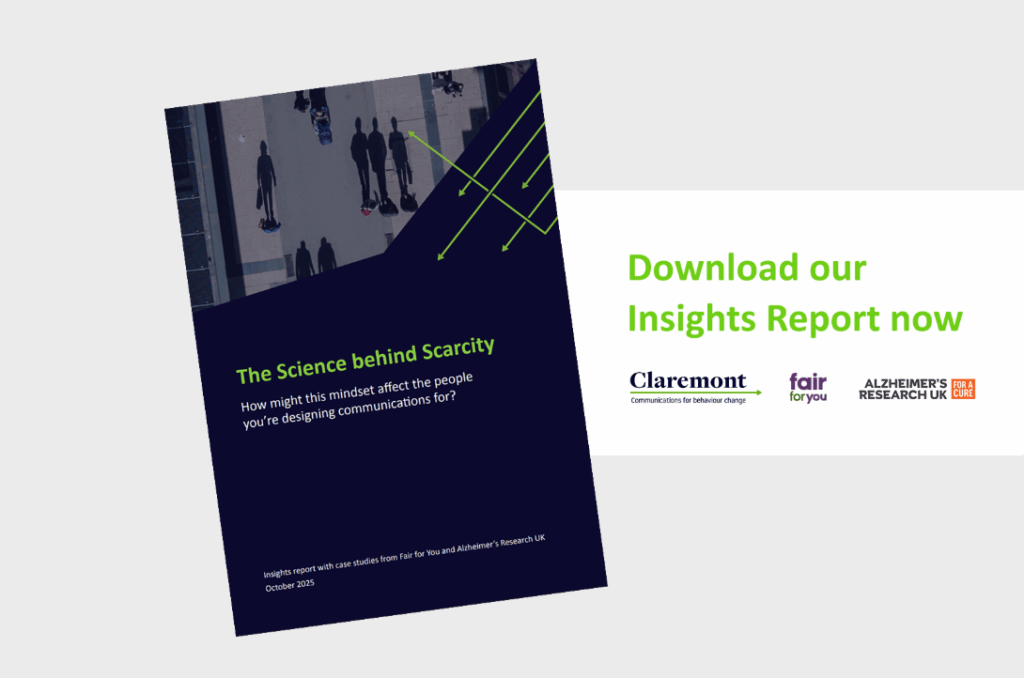Designing for Scarcity: How Behavioural Insights Can Improve Engagement

On October 23rd, we launched Bitesize: Claremont’s new webinar series of short, sharp 30-minute sessions where we share insights from the behavioural science and research work we’ve been doing at Claremont.
Our first session was hosted by Phillipa Williams and Cynthia Ko who explored why scarcity matters and how to design with it in mind. Read below for the key takeaways – and grab our full report at the end!
Why talk about scarcity?
Scarcity is a common thread in many public health and social challenges. Whether encouraging vaccine uptake, promoting dementia prevention, or supporting literacy, we often work with people juggling limited resources — time, money, health, or emotional support.
Understanding scarcity is crucial because it doesn’t just make life harder; it changes how people think and act. When resources are tight, mental bandwidth shrinks, priorities narrow, and decision-making becomes harder.
What does scarcity look like?
Scarcity can take many forms:
- Time scarcity – too many demands, not enough hours.
- Financial scarcity – limited income or access to affordable credit.
- Health scarcity – lack of energy or access to care.
- Social/emotional scarcity – isolation or limited support networks.
Certain groups—single parents, gig workers, ethnic minority communities, and those with long-term health conditions—are particularly vulnerable. They often face consistent shortfalls and higher exposure to shocks like job loss or sudden expenses.
The impact on behaviour
Scarcity affects the mind in three key ways:
- Cognitive strain and emotional distress
Reduced mental bandwidth makes planning and problem-solving harder. Research shows financial stress can lower cognitive performance by up to 10 IQ points. - Mental shortcuts
When bandwidth is low, people rely on biases like present bias (prioritising short-term gains over future benefits), status quo bias (sticking with defaults to avoid effort) and loss aversion: avoiding risk at all costs. - Avoidant behaviour
Overwhelm leads to disengagement – ignoring bills, postponing health checks, or avoiding difficult conversations.
Case study: Fair for You
Claremont worked with ethical lender Fair for You to tackle a common challenge: customers disengaging when they couldn’t make payments. The goal? Encourage contact so support options could be offered.
The solution was rooted in four key principles rooted in behavioural insight:
- Compassion over empathy – acknowledging difficulty without claiming to fully understand it.
- Empowerment – reinforcing belief that customers can get back on track.
- Simplicity and clarity – clean design, single-minded actions, and clear options.
- Safety with urgency – balancing consequences with supportive tone.
Testing showed that championing language (“Let’s fix this together”) and soft, approachable design built trust and engagement.
What does this mean in practice?
Scarcity can affect anyone, but it disproportionately impacts vulnerable groups. Whether designing interventions for financial support, health behaviour change, or social care, these principles apply. Start with insight, test your approach, and keep simplicity and compassion at the heart of your design.
Want to learn more?
Rewatch the event recording and download Claremont’s full report for deeper insights and practical examples from both Fair for You and Alzheimer’s Research UK. Also keep an eye out for future Bite Size sessions!
